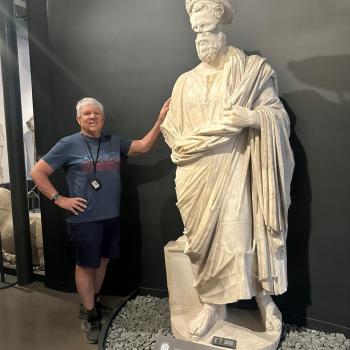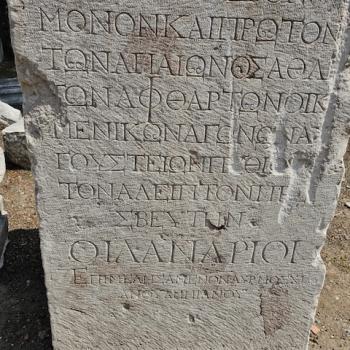 Meet Hassan Saida. By day a truck driver, by night a cave crawler. He lives in the northern part of the Galilee, and claims he found these lead objects in a cave (where else) northeast of the Sea of Galilee near the conjunction of Israel Jordan and Syra, near the town of Saham, Jordan. Jordanian officials naturally want these object back and are making large claims about their importance in regard to Jesus and the history of his earliest followers. The region, to be sure is a place where Jews on the run did hide from time to time, for example during and after the first Jewish war in the 60s and the Bar Kokhba revolt in the early second century. Could this cave have been a stopping off point for Christians fleeing the destruction of Jerusalem, say headed to Pella, as tradition says? It’s not impossible. But what do we have, and what do we really know about what we have here? Not much thus far.
Meet Hassan Saida. By day a truck driver, by night a cave crawler. He lives in the northern part of the Galilee, and claims he found these lead objects in a cave (where else) northeast of the Sea of Galilee near the conjunction of Israel Jordan and Syra, near the town of Saham, Jordan. Jordanian officials naturally want these object back and are making large claims about their importance in regard to Jesus and the history of his earliest followers. The region, to be sure is a place where Jews on the run did hide from time to time, for example during and after the first Jewish war in the 60s and the Bar Kokhba revolt in the early second century. Could this cave have been a stopping off point for Christians fleeing the destruction of Jerusalem, say headed to Pella, as tradition says? It’s not impossible. But what do we have, and what do we really know about what we have here? Not much thus far.
We know that the codices range in size from 3 inches by 2 inches, to 1o inches by 8 inches and that some of them are sealed, and that there seem to be an awful lot of them— up to 70. Was their a scribal archivist busily creating these things, or carrying them as Jews or Christians were fleeing? Who knows. Some scholars have already identified one of the pictures as that of Jerusalem, and one has even said, complete with picture of the empty tomb of Jesus! Well, we shall see about that. The point is we have to abide our souls in patience. Much scholarly work needs to be done before any firm conclusions can be drawn. It does look like we have some sort of paleo-Hebrew or Aramaic script on some of these lead plates, but there also appears to be some code and one conjectures is that actually we have Phoenician script here. (Maybe this was the Syro-Phoenician woman’s personal library—— just kidding). One plate seems to have palm trees, bits of walls, and maybe a menorah. It’s hard to tell.
 For one thing, we are simply taking Hassan’s word for where these codices came from. They are officially unprovenanced since they were not found as a part of an archaeological dig, and apparently no one but Hassan was present at their discovery. This is one of the reasons scholars are rightly warning we must not jump to conclusions about this find. Careful interpretive work, including studying the epigraphy and translating by relevant experts is required, and will take time. Still what we can see thus far is intriguing, including the stamped out image of a bearded man on one plate (see below). Already the conjecture is it is Jesus with a crown of thorns. It could just as easily be a bearded emperor like Nero or a hero like Herakles (Hercules) with the radiant crown suggesting divinity. Here is the link to the story in the Daily Mail, which naturally also makes out-sized claims that are only conjectures at this point.
For one thing, we are simply taking Hassan’s word for where these codices came from. They are officially unprovenanced since they were not found as a part of an archaeological dig, and apparently no one but Hassan was present at their discovery. This is one of the reasons scholars are rightly warning we must not jump to conclusions about this find. Careful interpretive work, including studying the epigraphy and translating by relevant experts is required, and will take time. Still what we can see thus far is intriguing, including the stamped out image of a bearded man on one plate (see below). Already the conjecture is it is Jesus with a crown of thorns. It could just as easily be a bearded emperor like Nero or a hero like Herakles (Hercules) with the radiant crown suggesting divinity. Here is the link to the story in the Daily Mail, which naturally also makes out-sized claims that are only conjectures at this point.
http://www.dailymail.co.uk/news/article-1372741/Hidden-cave-First-portrait-Jesus-1-70-ancient-books.html# The press of course loves to jump to conclusions. Scholars should look before they leap. All I am prepared to say is this stuff looks interesting. It needs to go through a battery of authenticity tests as to age etc. Epigraphers need to analyze the language. Historians of art need to analyze the images. And Hassan needs to be carefully cross-examined by a bunch of scholars. Then the codices need to be placed into the hands of a panel of competent scholars to study at length, if and when the authenticity tests show they are ancient, and not yet another modern hoax. As the old saying goes— ‘fool me once, shame on you. Fool me twice shame on me.’ (Thanks to James Foster for the link to the story).














